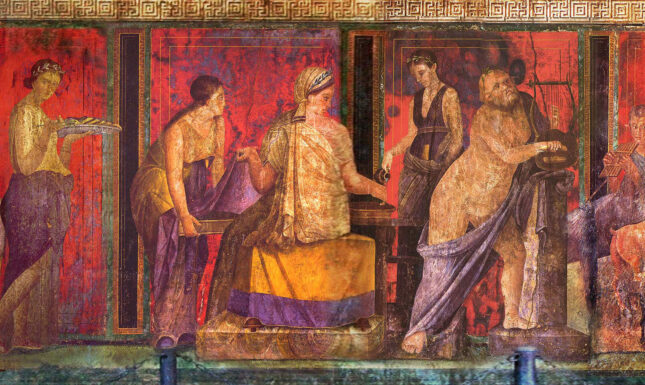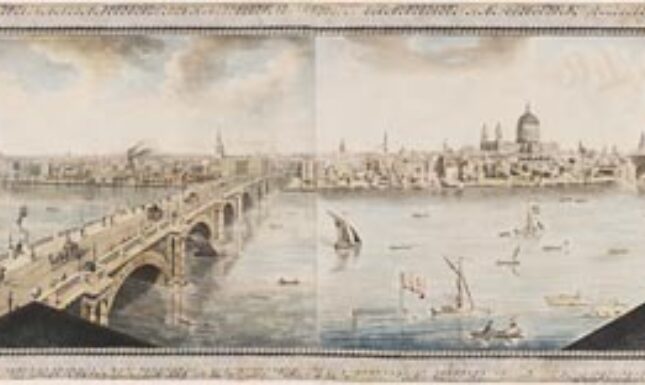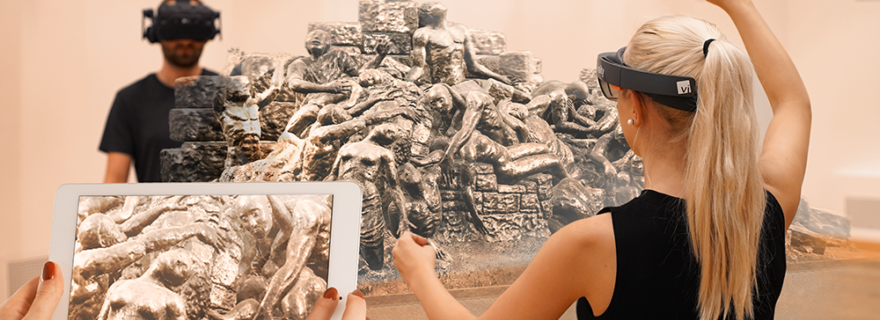The History of VR – An Ancient Pursuit
When did humanity first begin to create the sensation of being in VR? Miguel Mira reflects on the history of the medium, considering Oliver Grau’s theory on the immersive qualities of the Villa dei Misteri all the way to Morton Heilig’s Sensorama machine.
Currently, virtual reality (VR) is a medium that is evermore present in our cultural zeitgeist [time spirit]. Today dear reader, we would be hard-pressed to find anyone who does not know what the acronym VR abbreviates. Nowadays, the “hype” around the medium is palpable. VR companies sold nearly 15.49 million head-mounted displays (HMDs), the main apparatus for consumption, in 2022.
Yet, this has not always been the case, and the necessary question arises: When did VR commence? How was VR employed and perceived before digital technology? How did we transport the other into a feeling of being elsewhere via a simulacrum?
We first require an operational definition of the term VR to explore these questions. If we observe the academic discourse surrounding the term, we will find that academics want to unlink the technological apparatus to the phenomenological sensation. Jonathan Steuer begins to nudge towards this unlinking of the term in 1993 with Defining Virtual Reality: Dimensions Determining Telepresence. He states: “Communication researchers, policy makers, software developers, or media consumers, a device driven definition of virtual reality is unacceptable: It fails to provide any insight into the processes or effects of using these systems, fails to provide a conceptual framework from which to make regulatory decisions, fails to provide an aesthetic from which to create media products, and fails to provide a method for consumers to rely on their experiences with other media in understanding the nature of virtual reality” (4).
Steuer begins a tradition of uncoupling the technological apparatus with the sensation of inhabiting a simulacrum, that is, a place where reality has been replaced by representation. Thus, for Steuer, in order to discuss VR, we must understand that it is not the technological device per se that defines the medium. As technology can always be superseded by ever-increasingly cutting-edge mechanisms of transmitting the feeling of being elsewhere. Nicholas Burbles follows this line of thought in 2004 with Rethinking the Virtual stating that, “the key feature of the virtual is not the particular technology that produces the sense of immersion, but the sense of immersion itself (whatever might bring it about), which gives the virtual its phenomenological quality of an ‘as if’ experience” when discussing virtuality” (163).
Therefore, VR is not an HMD or a CAVE System (Cave Automatic Virtual Environment) or any other future apparatuses that we may employ to conjure that “as if” feeling, it is the very sensation itself of being immersed in a simulacrum, a reality that is manufactured. However, dear reader, although we can agree with Steuer and Burbles that VR is best understood as a phenomenological sensation, we should not disjoin the employment of an apparatus in the pursuit of creating an alternative reality completely from the definition. Consider how difficult it would be to transport someone into attaining the feeling that they are in an alternate reality without the use of a device.
Oliver Grau, in his book, Visual Art: Illusion and Immersion (2003) argues that we have attempted to use art forms, such as architecture and illustration to immerse the other in a simulacrum at least as far back as the ancient Roman era. In the aforementioned book, Grau ponders on the immersive nature of the Villa dei Misteri, which is an elaborate villa located in Pompeii. The villa contains a series of frescoes depicting people dancing, playing instruments, eating and drinking wine. By covering all four walls of the room Grau argues that these frescoes, with their detailed depictions and spatial arrangement, aimed to envelop the viewer and transport ancient Romans into an alternate reality, by having the spectator partake in the depicted activities. Thus, this engagement with the artwork goes beyond mere observation, enabling viewers to imaginatively immerse themselves in the depicted ceremonies and become one with what is occurring in the frescos by participating in the same activities that the frescoes are depicting.


It is only much later, in 1787, that we can say for certain that the feeling of transportation of the other is the intended authorial aim of illustrations. Scottish Painter Sir Robert Barker painted monumental panoramic canvases with the aim of enveloping the viewers' sense of sight in his creations with the objective to " feel as if really on the very spot" (3). This historical quote is a pivotal moment, for it demarcates the intent of the author to create Burbles’ “as if” sensation even before mechanization or digitalization of the means of eliciting the feeling of inhabiting a VR.


Sir Charles Wheatstone follows that tradition, but unlike Barker, who used enormous canvases, Wheatstone opted for a smaller device. He constructs the stereoscope a device with elementary simplistic beauty that feeds two distinct images of the same scene to each eye independently so that the mind produces the image with a sense of three-dimensional depth.
Video of astrophysicist and guitarist Sir Brian May discussing early stereoscopy: Brian May - Stereoscopy #1 - An introduction.These pioneers despite their limitations were pushing the technological boundaries of their time to invoke the sensation of being in a VR. But from here dear reader is where I believe a distinction is in order, for up until now we have had the era of non-mechanized VR. A sense of being elsewhere without the usage of mechanized devices. However, this all changed with Morton Heilig and his device, the Sensorama. In 1962 Heilig utilized an arcade-style machine, to feed all five senses except taste. The Sensorama was equipped with stereoscopic imagery, stereo sound, a haptic vibrating chair and a scent dispenser that could be loaded with up to 50 scents. Yet this device never went past the prototyping stages, proving to be too expensive to mass manufacture.
Video of Istuo Sakane’s interview of Morton Heilig discussing the Sensorama: Morton Heilig's Sensorama (Interview).movContemporary to Heilig is the research conducted by the “Father of Computer Graphics” Ivan Sutherland. Sutherland constructed an apparatus titled the Sword of Damocles. This was the first HMD that reacted to the spectator’s head motion with corresponding graphics. An indisputable milestone for how we consume VR today.
Video of Ivan Sutherland’s Sword of Damocles in use: Sword of Damocles (1966) - First augmented reality head-mounted displayUltimately my suggestion is that when discussing VR ontology and history we disjoin the definition of VR to a specific device or apparatus, as Steuer suggests, but we do not lose sight of the fact that it is always via a specific media that we construct VR in our minds. As we reflect on the journey from Robert Barker to Ivan Sutherland, we witness the evolution of virtual reality from its nascent stages to the transformative technology many enjoy today. The collective efforts of these remarkable individuals and countless others have propelled virtual reality from the realm of imagination to the forefront of innovation.
REFERENCES
Burbules, Nicholas. “Rethinking the Virtual” Sage Journals. June 2004. https://journals.sagepub.com/doi/epdf/10.2304/elea.2004.1.2.2
Grau, Oliver. “Visual Art: From Illusion to Immersion” MIT Press. 2003. http://www.virose.pt/blog/atelier1multimedia/wp-content/uploads/2017/02/INTRO_Oliver-Grau-Virtual-Art-From-Illusion-to-Immersion.pdf
Heilig, Moton. “EL Cine del Futuro: The Cinema of the Future.” MIT Press. Summer, 1992. https://direct.mit.edu/pvar/article-abstract/1/3/279/58782/EL-Cine-del-Futuro-The-Cinema-of-the-Future?redirectedFrom=fulltext
May, Brian. “Brian May - Stereoscopy #1 - An introduction” YouTube, January 4 2015, https://youtu.be/dDYfEM03abA
Sakane, Itsuo. “Morton Heilig's Sensorama (Interview).mov” YouTube, January 5 2011, https://youtu.be/vSINEBZNCks
Steuer, Jonather. “Defining Virtual Reality: Dimensions Determining Telepresence” Social Responds to Communication Technology. October 15, 1993. http://papers.cumincad.org/data/works/att/27eb.content.pdf
Ultimate History of Video Games. “Sword of Damocles (1966) – First augmented reality head-mounted display” YouTube, 22 April 2018, https://youtu.be/eVUgfUvP4uk
Uricchio, William. “A ‘Proper Point of View’: the panorama and some of its early media Iterations” MIT & Utrecht University. 2011. http://web.mit.edu/uricchio/Public/pdfs/pdfs/A%20_Proper%20Point%20of%20View_%20MSW.pdf



0 Comments